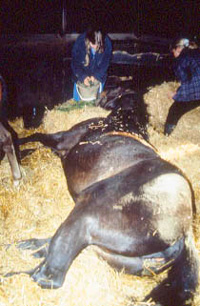Equine Herpesvirus type 1 as a cause of neurological signs

Dr. Richard Newton (Animal Health Trust, Reino Unido)
Equine Herpesvirus type 1 (EHV-1) is a common virus which is distributed worldwide and causes respiratory disease in young horses, abortion in mares and myeloencephalopathy in horses of any age.
Neurological signs caused by EHV-1 can range from a slight incoordination or ataxia of the hind limbs to a complete paralysis where the horse is unable to stand up. The onset of the paralysis can be sudden, and very often there are no preliminary respiratory signs.
Within the risk factors associated with this disease the age (it is more prevalent in horses older than 5 years) and the season (it is more prevalent in autumn, winter and spring) are the most relevant. It has been reported that the strain of the virus could be related to the appearance of neurological signs, existing “neurological” strains and “non-neurological” strains; however there are reports of horses with neurological signs infected with “non-neurological” strains.
Any horse with incoordination, ataxia or recumbency should be treated as suspicious of being infected with EHV-1 and the horse should be isolated from other horses until the infection with EHV-1 has been ruled out.
Which measures should be undertaken in a yard or stud farm where there is a suspicion of infection with EHV-1?
In any horse with neurological signs and suspicious of being infected with EHV-1, the following measures should be undertaken:
- If it is a stud farm, all the breeding activities should be stopped.
- Any movements of horses in and out of the premises should be restricted.
- The horse showing neurological signs should be isolated and attended by dedicated staff, different to the staff who takes care of the rest of the horses in the premises.
- The appropriate samples should be taken from the affected horse and the horses that were in contact, in order to confirm or rule out the infection with EHV-1.
- The bedding (Straw/shavings) from the affected horse should be disinfected and destroyed, and the premises should be cleaned and disinfected.
How to diagnose EHV-1?
Whenever there is a suspicion of EHV-1 causing neurological signs in a horse, the most appropriate samples in order to confirm the infection by quantitative PCR are the following:
- Nasopharyngeal swab.
- Total blood in Heparin (30 ml – 3 tubes of 10 ml).
If the horse is unvaccinated against EHV-1/EHV-4, the diagnosis could be performed by serology. A blood sample should be drawn in a tube without anticoagulants (10 ml) when the first clinical signs are seen, and a second sample should be drawn 14 days later in order to confirm a seroconversion and therefore infection with the virus. Serology would be the preferred diagnostic method in those horses that have been in contact with the affected horse in which ruling out the infection is needed in order to leave the premises.
If the infection with EHV-1 is confirmed…
If the infection with EHV-1 is confirmed, the following measures should be implemented in the premises:
- The affected horse should be isolated and attended by dedicated staff until it is confirmed that it is free from infection by EHV-1 (A second nasopharyngeal swab / heparinised blood sample should be taken 14 days after the first clinical signs in order to confirm the absence of EHV-1 by quantitative PCR).
- If the affected horse is euthanized or dies during the infection process, the carcase should be transported in biosecurity conditions to an appropriate premises in order to be destroyed.
- Biosecurity conditions, preventive measures and restriction of movements in the premises should be maintained, at least until it is confirmed that there is no active infection (neither in the affected horse nor in the horses that were in contact).
For further information and the consultation of questions regarding the diagnosis, treatment of equine infectious diseases or measures of prevention and control of an outbreak:
Equine Health Surveillance Unit
VISAVET Health Surveillance Centre)
Complutense University
Tel.: (+34) 913943999
seviseq@ucm.es
Bibliography
- Allen G.P. 2002. Respiratory Infections by Equine Herpesvirus Types 1 and 4. In: Equine Respiratory Diseases. Ed. P. Lekeux, International Veterinary Information Service Ithaca, New York.
- Crabb B.S., Studdert M.J. 1995. Equine herpesviruses 4 (equine rhinopneumonitis virus) and 1 (equine abortion virus). Adv. Virus. Res. 45:153-190.
- Diallo S.I., Hewitson G., Wright L., Rodwell B.J., Corney B.G.. 2006. Detection of equine herpesvirus type 1 using a real-time polymerase chain reaction. J. Virol. Meth.. 131:92-98.
- Diallo S.I., Hewitson G., Wright L.L., Kelly M.A., Rodwell B.J., Corney B.G. 2007. Multiplex real-time PCR for the detection and differentiation of equid herpesvirus 1 (EHV-1) and equid herpesvirus 4 (EHV-4). Vet. Microbiol.. 123:93–103.
- Equine rhinopneumonitis. OIE Manual of Diagnostic Tests and Vaccines for Terrestrial Animals 2013. Chapter 2.5.9.
- Meyer H., Thein P., Hubert P. 1987. Characterization of two equine herpesvirus (EHV) isolates associated with neurological disorders in horses. Zentralbl. Veterinarmed. B. 34:545-548.
- Van Maanen C., Sloet van Oldruitenborgh-Oosterbaan M.M., Damen E.A., Derksen A.G. 2001. Neurological disease associated with EHV-1 infection in a riding school: clinical and virological characteristics. Equine Vet. J. 33:191-196.
- Van Maanen C., Vreeswijk J., Moonen P., Brinkhof J., de Boer-Luijtze E., Terpstra C. 2000. Differentiation and genomic and antigenic variation among fetal, respiratory, and neurological isolates from EHV1 and EHV4 infections in The Netherlands. Vet. Q. 22:88-93.


